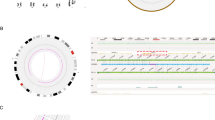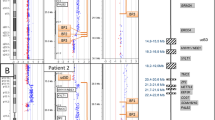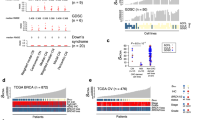Abstract
For several decades etiological diagnosis of patients with idiopathic mental retardation (MR) and multiple congenital anomalies (MCA) has relied on chromosome analysis by karyotyping. Conventional karyotyping allows a genome-wide detection of chromosomal abnormalities but has a limited resolution. Recently, array-based comparative genomic hybridization (array CGH) technologies have been developed to evaluate DNA copy-number alterations across the whole-genome at a much higher resolution. It has proven to be an effective tool for detection of submicroscopic chromosome abnormalities causing congenital disorders and has recently been adopted for clinical applications. Here, we investigated four high-density array platforms with a theoretical resolution ⩽100 kb: 33K tiling path BAC array, 500K Affymetrix SNP array, 385K NimbleGen oligonucleotide array and 244K Agilent oligonucleotide array for their robustness and implementation in our diagnostic setting. We evaluated the practical performance based on the detection of 10 previously characterized abnormalities whose size ranged from 100 kb to 3 Mb. Furthermore, array data analysis was performed using four computer programs developed for each corresponding platform to test their effective ability of reliable copy-number detection and their user-friendliness. All tested platforms provided sensitive performances, but our experience showed that accurate and user-friendly computer programs are of crucial importance for reliable copy-number detection.
Similar content being viewed by others
Log in or create a free account to read this content
Gain free access to this article, as well as selected content from this journal and more on nature.com
or
References
de Vries BB, Pfundt R, Leisink M et al: Diagnostic genome profiling in mental retardation. Am J Hum Genet 2005; 77: 606–616.
Schoumans J, Ruivenkamp C, Holmberg E, Kyllerman M, Anderlid BM, Nordenskjold M : Detection of chromosomal imbalances in children with idiopathic mental retardation by array based comparative genomic hybridisation (array-CGH). J Med Genet 2005; 42: 699–705.
Shaw-Smith C, Redon R, Rickman L et al: Microarray based comparative genomic hybridisation (array-CGH) detects submicroscopic chromosomal deletions and duplications in patients with learning disability/mental retardation and dysmorphic features. J Med Genet 2004; 41: 241–248.
Tyson C, Harvard C, Locker R et al: Submicroscopic deletions and duplications in individuals with intellectual disability detected by array-CGH. Am J Med Genet A 2005; 139: 173–185.
Vissers LE, de Vries BB, Osoegawa K et al: Array-based comparative genomic hybridization for the genomewide detection of submicroscopic chromosomal abnormalities. Am J Hum Genet 2003; 73: 1261–1270.
Friedman JM, Baross A, Delaney AD et al: Oligonucleotide microarray analysis of genomic imbalance in children with mental retardation. Am J Hum Genet 2006; 79: 500–513.
Menten B, Maas N, Thienpont B et al: Emerging patterns of cryptic chromosomal imbalance in patients with idiopathic mental retardation and multiple congenital anomalies: a new series of 140 patients and review of published reports. J Med Genet 2006; 43: 625–633.
Rosenberg C, Knijnenburg J, Bakker E et al: Array-CGH detection of micro rearrangements in mentally retarded individuals: clinical significance of imbalances present both in affected children and normal parents. J Med Genet 2006; 43: 180–186.
Fan YS, Jayakar P, Zhu H et al: Detection of pathogenic gene copy number variations in patients with mental retardation by genomewide oligonucleotide array comparative genomic hybridization. Hum Mutat 2007; 28: 1124–1132.
Slater HR, Bailey DK, Ren H et al: High-resolution identification of chromosomal abnormalities using oligonucleotide arrays containing 116,204 SNPs. Am J Hum Genet 2005; 77: 709–726.
Veltman JA, de Vries BB : Whole-genome array comparative genome hybridization: the preferred diagnostic choice in postnatal clinical cytogenetics. J Mol Diagn 2007; 9: 277.
Bonaglia MC, Giorda R, Mani E et al: Identification of a recurrent breakpoint within the SHANK3 gene in the 22q13.3 deletion syndrome. J Med Genet 2006; 43: 822–828.
Barbaro M, Oscarson M, Schoumans J, Staaf J, Ivarsson SA, Wedell A : Isolated 46,XY gonadal dysgenesis in two sisters caused by a Xp21.2 interstitial duplication containing the DAX1 gene. J Clin Endocrinol Metab 2007; 92: 3305–3313.
Anderlid BM, Schoumans J, Anneren G et al: FISH-mapping of a 100-kb terminal 22q13 deletion. Hum Genet 2002; 110: 439–443.
Anderlid BM, Schoumans J, Hallqvist A et al: Cryptic subtelomeric 6p deletion in a girl with congenital malformations and severe language impairment. Eur J Hum Genet 2003; 11: 89–92.
Schoumans J, Sanner G, Nordenskjold M, Anderlid BM : Detailed clinical description of four patients with 1.3 and 2.1 Mb chromosome imbalances derived from a familial t(12;17)(q24.33;q25.3). Am J Med Genet A 2005; 134: 254–258.
Schoumans J, Wincent J, Barbaro M et al: Comprehensive mutational analysis of a cohort of Swedish Cornelia de Lange syndrome patients. Eur J Hum Genet 2006; 15: 143–149.
Krzywinski M, Bosdet I, Smailus D et al: A set of BAC clones spanning the human genome. Nucleic Acids Res 2004; 32: 3651–3660.
Knight SJ, Lese CM, Precht KS et al: An optimized set of human telomere clones for studying telomere integrity and architecture. Am J Hum Genet 2000; 67: 320–332.
Jonsson G, Staaf J, Olsson E et al: High-resolution genomic profiles of breast cancer cell lines assessed by tiling BAC array comparative genomic hybridization. Genes Chromosomes Cancer 2007; 46: 543–558.
Schoumans J, Johansson B, Corcoran M et al: Characterisation of dic(9;20)(p11–13;q11) in childhood B-cell precursor acute lymphoblastic leukaemia by tiling resolution array-based comparative genomic hybridisation reveals clustered breakpoints at 9p13.2 and 20q11.2. Br J Haematol 2006; 135: 492–499.
Saal LH, Troein C, Vallon-Christersson J, Gruvberger S, Borg A, Peterson C : BioArray Software Environment (BASE): a platform for comprehensive management and analysis of microarray data. Genome Biol 2002; 3: SOFTWARE0003.
Hupe P, Stransky N, Thiery JP, Radvanyi F, Barillot E : Analysis of array CGH data: from signal ratio to gain and loss of DNA regions. Bioinformatics 2004; 20: 3413–3422.
Nannya Y, Sanada M, Nakazaki K et al: A robust algorithm for copy number detection using high-density oligonucleotide single nucleotide polymorphism genotyping arrays. Cancer Res 2005; 65: 6071–6079.
Lin M, Wei LJ, Sellers WR, Lieberfarb M, Wong WH, Li C : dChipSNP: significance curve and clustering of SNP-array-based loss-of-heterozygosity data. Bioinformatics 2004; 20: 1233–1240.
Vermeesch JR, Fiegler H, de Leeuw N et al: Guidelines for molecular karyotyping in constitutional genetic diagnosis. Eur J Hum Genet 2007; 15: 1105–1114.
Coe BP, Ylstra B, Carvalho B, Meijer GA, Macaulay C, Lam WL : Resolving the resolution of array CGH. Genomics 2007; 89: 647–653.
Hehir-Kwa JY, Egmont-Petersen M, Janssen IM, Smeets D, van Kessel AG, Veltman JA : Genome-wide copy number profiling on high-density bacterial artificial chromosomes, single-nucleotide polymorphisms, and oligonucleotide microarrays: a platform comparison based on statistical power analysis. DNA Res 2007; 14: 1–11.
Iafrate AJ, Feuk L, Rivera MN et al: Detection of large-scale variation in the human genome. Nat Genet 2004; 36: 949–951.
Sebat J, Lakshmi B, Troge J et al: Large-scale copy number polymorphism in the human genome. Science 2004; 305: 525–528.
Redon R, Ishikawa S, Fitch KR et al: Global variation in copy number in the human genome. Nature 2006; 444: 444–454.
Qiao Y, Liu X, Harvard C et al: Large-scale copy number variants (CNVs): distribution in normal subjects and FISH/real-time qPCR analysis. BMC Genomics 2007; 8: 167.
Acknowledgements
The work was financially supported by the Swedish Research Council, Frimurarna Barnahuset Foundation and the Gerber Foundation.
Author information
Authors and Affiliations
Corresponding author
Rights and permissions
About this article
Cite this article
Zhang, ZF., Ruivenkamp, C., Staaf, J. et al. Detection of submicroscopic constitutional chromosome aberrations in clinical diagnostics: a validation of the practical performance of different array platforms. Eur J Hum Genet 16, 786–792 (2008). https://doi.org/10.1038/ejhg.2008.14
Received:
Revised:
Accepted:
Published:
Issue date:
DOI: https://doi.org/10.1038/ejhg.2008.14
Keywords
This article is cited by
-
Molecular and clinical delineation of the 17q22 microdeletion phenotype
European Journal of Human Genetics (2013)
-
Evaluation of high-resolution microarray platforms for genomic profiling of bone tumours
BMC Research Notes (2010)
-
High-resolution SNP arrays in mental retardation diagnostics: how much do we gain?
European Journal of Human Genetics (2010)
-
Molecular karyotyping in 17 patients and mutation screening in 41 patients with Kabuki syndrome
Journal of Human Genetics (2009)
-
A new diagnostic workflow for patients with mental retardation and/or multiple congenital abnormalities: test arrays first
European Journal of Human Genetics (2009)



